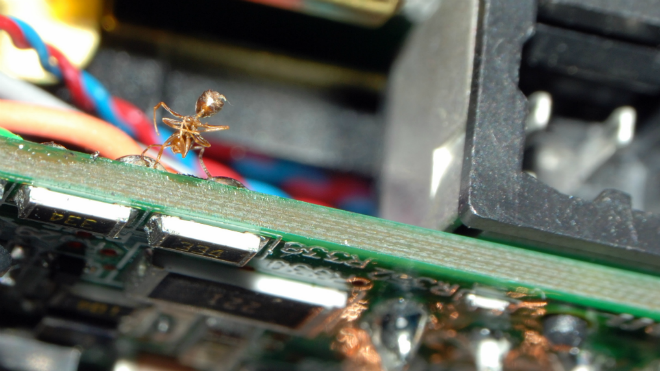
Are fire ants attracted to electric fields? I became curious about this recently when I discovered a fire ant whose feelers came across the contact points of a flash board of a DSLR camera I was repairing, fusing it there for me to find. While the ant didn’t cause the need for repair (a good drop was responsible), had there been more ants, it would have shorted out the whole board.
Having personally crossed the flash contact points a few times, this could not have been a pleasant way to go. The average DSLR capacitor holds 330 volts. The worst shock I got like this left a pinhead size area of my thumb looking, feeling, and smelling like a charred hotdog. It felt like all the muscles in my body were forced to tighten up, I couldn’t pull my hands away (for what felt like a few seconds but was probably only an instant), and I momentarily lost control of my legs and arms; my leg actually jumped up, mashing my knee pretty hard on the underside of my desk. This is why you should never try this at home.
Fire ants were first seen in the United States in the 1930’s when they came to a Mobile, Alabama seaport on cargo ships from Brazil. As of 2011, they have been reported to be in all southern U.S. states and continue to spread. The search for something safe and effective to be used to combat these imported pests continues, but unfortunately the ants are also adapting to our efforts. For now, the best defenses are epoxy to seal them out and pesticides.Â
These little red irritants cost billions of dollars annually in medical treatment, damage, and control. Electricians, AC technicians, and farm owners discover them regularly. Masses of them are found in transformers, electrical control boxes, relays, or nearly anything that has an electric field. Apparently in Texas, fire ants are the leading cause of traffic light shorts. Some suggest that they are simply foraging for food when they come across electrical contacts. When shocked they release an ant pheromone which signals that it is under attack, calling out to other nearby ants. In response, the ants swarm around the original ant. This causes more to get shocked releasing more pheromone and attracting more ants resulting in shorting and electrical failure. Others suggest that they are simply attracted to electricity, so much so that they forget about their “ant duties†and all swarm around it.
Currently there is no conclusive evidence either way as to why this happens. In my opinion, they are attracted to the electrical field initially and the resulting pheromone release from the shock is likely the cause of the swarming. The only other thing I’ve seen in my many years as a professional camera repair technician that was even remotely similar was termite mud and tubes in a point-and-shoot camera, but that story is for another time…